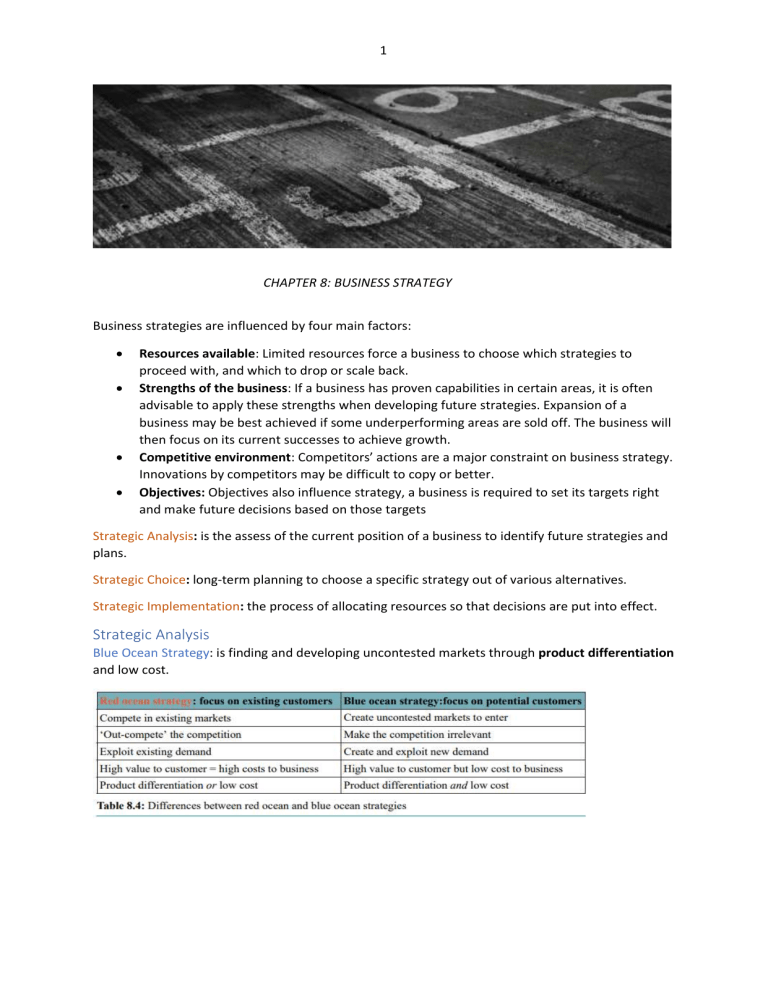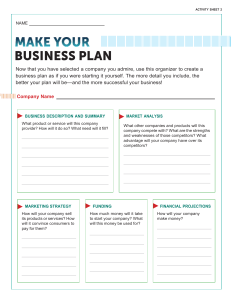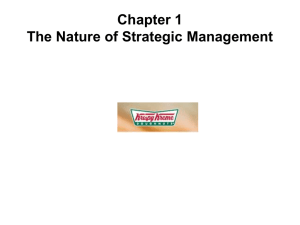
1 CHAPTER 8: BUSINESS STRATEGY Business strategies are influenced by four main factors: Resources available: Limited resources force a business to choose which strategies to proceed with, and which to drop or scale back. Strengths of the business: If a business has proven capabilities in certain areas, it is often advisable to apply these strengths when developing future strategies. Expansion of a business may be best achieved if some underperforming areas are sold off. The business will then focus on its current successes to achieve growth. Competitive environment: Competitors’ actions are a major constraint on business strategy. Innovations by competitors may be difficult to copy or better. Objectives: Objectives also influence strategy, a business is required to set its targets right and make future decisions based on those targets Strategic Analysis: is the assess of the current position of a business to identify future strategies and plans. Strategic Choice: long-term planning to choose a specific strategy out of various alternatives. Strategic Implementation: the process of allocating resources so that decisions are put into effect. Strategic Analysis Blue Ocean Strategy: is finding and developing uncontested markets through product differentiation and low cost. 2 Scenario Planning: is the identifying of possible future circumstances of a business and how to respond to them. SWOT Analysis: identifies and analyses the internal factors (strengths & weakness) and external factors (opportunities & threats) of a business. It also influences the future direction and success of a business. It consists of: Internal Factors: Strengths: this can be used as a basis for developing a competitive advantage which might include: experienced management, product patents, loyal workforce, and a good product range. Weakness: a spare equipment can be a strength to business in case of economic upturn but if it remains unused this could drive up the average cost. Weaknesses might include poorly trained workforce, limited production capacity and ageing equipment. External Factors: Opportunities: These are the potential areas for expansion of the business and future profits. Examples include: new technologies, export markets expanding faster than domestic markets, and lower interest rates increasing consumer demand. Threats: This analyses the business and economic environment, market conditions and the strength of competitors. Examples of threats include: new competitors entering the market, globalisation driving down prices, changes in the law regarding the sale of certain products, and changes in government economic policy. 3 PESTEL Analysis: is the strategic analysis of a firm's macro environment which includes political, economical, social and technological factors. It needs to be constantly updated to helps access the chance of success of a business strategy P – Political and legal [employment laws, environmental regulations, consumer protection laws] E – Economic [economic growth, exchange rate, tax, interest and inflation rates] S – Social [demographic changes, education, culture, labour skills] T – Technological [cost efficiency, R&D, innovation] Porter’s five forces analysis: is a method of analysing the competitive forces within an industry. Competitive rivalry – key, most important part Determines the level of competition in an industry Determined by the other 4 forces Helps firms identify whether to enter the market – profitability, competition, whether to stay in the market Develop strategies to improve competitive position Product differentiation Buying out rivals Market segmentation Communicate and collude with competitors Core competencies: is an important business capability that gives a firm comparative advantage. It depends on integrating multiple technologies and different product skills which already exist in the business Should be applicable to a range of different products and new markets Ansoff Matrix: is used to show the degree of risk associated with the four growth strategies: market penetration, market development, product development and diversification. Market penetration involves achieving higher market shares in existing markets with existing products 4 Product development involves the development and sale of new products into existing markets Market development involves selling existing products in new markets Diversification involves selling, different, unrelated products in new markets Force-field Analysis: It is a technique for identifying and analysing the positive factors (driving forces) that support a decision and negative factors (restraining forces) that constrain it. 1. 2. 3. 4. 5. 6. 7. To conduct a force-field analysis: Analyse the current and desired situation List all the driving forces List all the restraining forces Set scores to each force Chart the forces on diagram Total the scores Increase or decrease the strength of either forces Decision tree: is a diagram that sets out the possibilities and outcomes when choosing a decision. It also consists of many options that has a probability of occurring and an expected value that may result from the outcome. CHAPTER 9: CORPORATE PLANNING Corporate plan: is a plan containing details of a business's central objectives and the strategies to achieve them. Helps to have a clear focus and the sense of purpose to all managers, employees and other stakeholders Measure the performance of the business by comparing the objectives to actual outcomes Planning process helps managers consider the business’s strengths and weaknesses However, it could be outdated due to rapid changes in internal and external changes The plan must be adaptable and flexible The main influences on a corporate plan: Internal Financial resources Operating capacity Managerial skills and experience Staff numbers and skills Culture of the organisation External Macro-economic conditions Central bank and government policy changes Technology changes Competitors actions 5 Corporate culture: refers the values, attitudes and beliefs of the people working in an organization and the way they interact with each other including external stakeholders. It effects the way employees act or take decisions and gives and organization a sense of identity. Types of corporate culture: Power culture: associated with autocratic leadership style and power is concentrated among just a few ppl in the organization. Role culture: associated with bureaucratic organizations, each member has clearly defined job title and role. Little creativity is shown, and power is determined by a person's position Task culture: based on cooperation and teamwork, encouraged to be creative and take decisions Person culture: individuals are given the freedom to fully express themselves and make decisions. It is the most creative type of culture, although there could be conflicts between individual goals Entrepreneurial culture: encourages management and workers to take risks, to come up with new ideas and test out new business ventures. Success is rewarded but failure is not criticised Changes in corporate culture may occur due to: Product led business responds to changing market conditions Investors may demand more transparency and recognition Merger and takeover Declining profits and market share Change in economic conditions Transformational Leadership: is a leader that works with teams to identify the need for change, creates a vision to inspire people accept those change and implement change with cooperation of the team. 6 Process of promoting change: 1. Establish a sense of urgency 2. Create an effective project team to lead the change 3. Develop a vision and strategy for change 4. Communicate the changed vision 5. Empower people to take actions 6. Generate short term gains which benefit many people 7. Consolidate these gains to produce more change 8. Build change into the culture Reasons why managers and employees may resent and resist change: Fear of the unknown Fear of failure Losing something of value False beliefs about the need for change Lack of trust Inertia - reluctance to change in order to maintain their status quo Contingency Planning: a plan for preparing an organization’s resources for any unlikely events. It involves identifying how to minimise the potential impact of a disaster and prevent it from happening in the first place. In case of an unexpected emergency, crisis management might be required. Steps in contingency planning: 7 Identify the potential disasters that could affect the business Assess the likelihood of these occurring Minimise the potential impact of risks - Involves protecting the company’s assets, reputation and public goodwill Plan for continued operations of the business using continuity planning


